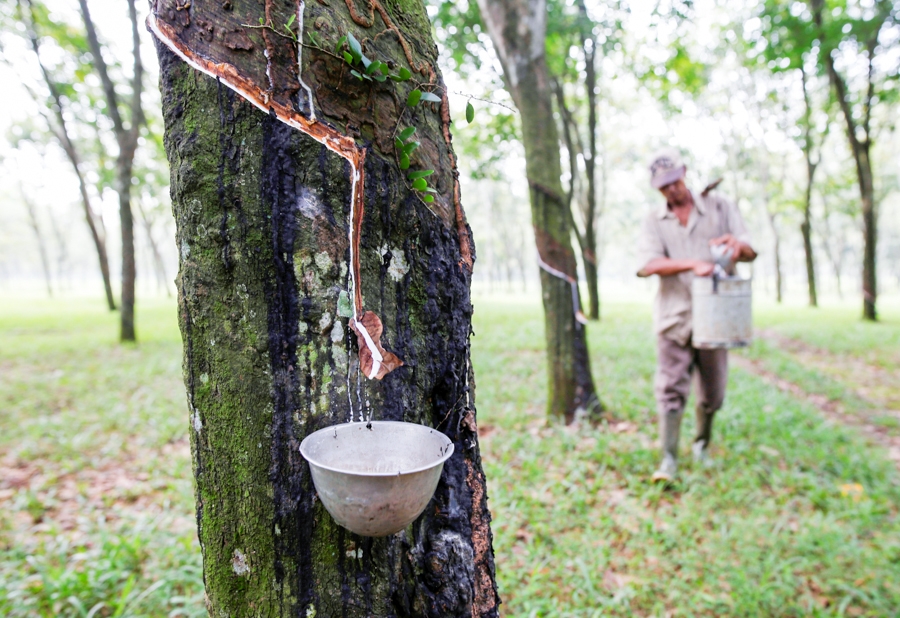While international rubber prices rebounded late last year, Cambodia’s exports in 2016, however, remained relatively unchanged compared with 2015, according to the Ministry of Agriculture, Forestry and Fisheries.
The ministry’s figures indicate that Cambodia exported 128,111 metric tons of rubber in 2016, with a marginal increase compared with 128,047 metric tons in 2015. The price of natural rubber rose from its lowest at $1.20 per kilogram in early 2016 to $1.60 in the last quarter of the year and $2.40 per kilogram in late 2016.

While international rubber prices rebounded late last year, Cambodia’s exports in 2016, however, remained relatively unchanged compared with 2015, according to the Ministry of Agriculture, Forestry and Fisheries.
The ministry’s figures indicate that Cambodia exported 128,111 metric tons of rubber in 2016, with a marginal increase compared with 128,047 metric tons in 2015. The price of natural rubber rose from its lowest at $1.20 per kilogram in early 2016 to $1.60 in the last quarter of the year and $2.40 per kilogram in late 2016.
According to experts in the rubber sector, the increase in prices will encourage the development of more rubber plantations in the country.
Lor Raksmey, spokesman for the Agriculture Ministry, said that though the total area of land in the country for rubber cultivation had increased, many of the areas were planted with young rubber trees that could not be tapped for latex yet.
Mr. Raksmey added that many plantation owners had replaced their rubber trees with other crops due to the low prices early last year.
“We don’t blame them for wanting to chop down their old rubber trees and replace them with other crops. It’s a case of economic necessity and a matter of survival,” he said.
The government, Mr. Raksmey said, could encourage plantation owners to continue planting rubber and not replace the crop when prices dropped. However, he added, the government could not intervene when prices fell in the international market.
Lim Heng, Vice President of An Mady Group Co., Ltd,. said he wants the government to consider bringing the export tax of rubber down, to keep the industry afloat.
“We want the rubber export tax to be revised to zero if the total export price is below $1,500 per metric ton changing it from the ceiling of $1,000 per metric ton,” he told Khmer Times.
At present, the government levies $50 in tax duty per metric ton of rubber exported if the price is from $1,000 to $2,000 per metric ton and $100 of tax duty per metric ton of rubber if the export price is above $2,000 per metric ton. It takes zero tax if the price is below $1,000 per metric ton.
“Neighboring countries don’t tax their rubber exports, so why are we doing it?” asked Mr. Heng.
Mr. Heng predicted that the price of rubber would rise in the coming years.
“OPEC countries are reducing their production to cause the price of oil to rise. This is good for natural rubber as oil is used to make synthetic alternatives. When the price of oil is high, it will be too expensive to make synthetic rubber, and natural rubber prices will rise,” he said.
The recent floods in southern Thailand have also affected rubber prices.
Thailand is one of the world’s most important producers of natural rubber and the national rubber authority recently said output in 2016-2017 would be about 10 percent lower because of the floods.
Global rubber prices have risen on concern about the impact. More rain is expected in the region in coming days, a top disaster agency official said on Sunday.
According to experts in the rubber sector, the increase in prices will encourage the development of more rubber plantations in the country.
Lor Raksmey, spokesman for the Agriculture Ministry, said that though the total area of land in the country for rubber cultivation had increased, many of the areas were planted with young rubber trees that could not be tapped for latex yet.
Mr. Raksmey added that many plantation owners had replaced their rubber trees with other crops due to the low prices early last year.
“We don’t blame them for wanting to chop down their old rubber trees and replace them with other crops. It’s a case of economic necessity and a matter of survival,” he said.
The government, Mr. Raksmey said, could encourage plantation owners to continue planting rubber and not replace the crop when prices dropped. However, he added, the government could not intervene when prices fell in the international market.
Lim Heng, Vice President of An Mady Group Co., Ltd,. said he wants the government to consider bringing the export tax of rubber down, to keep the industry afloat.
“We want the rubber export tax to be revised to zero if the total export price is below $1,500 per metric ton changing it from the ceiling of $1,000 per metric ton,” he told Khmer Times.
At present, the government levies $50 in tax duty per metric ton of rubber exported if the price is from $1,000 to $2,000 per metric ton and $100 of tax duty per metric ton of rubber if the export price is above $2,000 per metric ton. It takes zero tax if the price is below $1,000 per metric ton.
“Neighboring countries don’t tax their rubber exports, so why are we doing it?” asked Mr. Heng.
Mr. Heng predicted that the price of rubber would rise in the coming years.
“OPEC countries are reducing their production to cause the price of oil to rise. This is good for natural rubber as oil is used to make synthetic alternatives. When the price of oil is high, it will be too expensive to make synthetic rubber, and natural rubber prices will rise,” he said.
The recent floods in southern Thailand have also affected rubber prices.
Thailand is one of the world’s most important producers of natural rubber and the national rubber authority recently said output in 2016-2017 would be about 10 percent lower because of the floods.
Global rubber prices have risen on concern about the impact. More rain is expected in the region in coming days, a top disaster agency official said on Sunday.



























